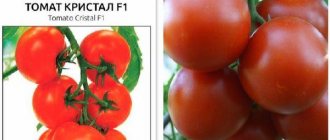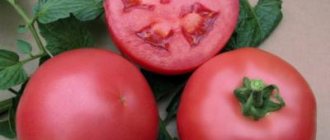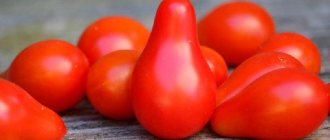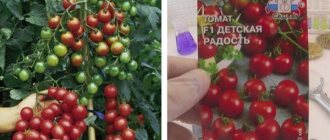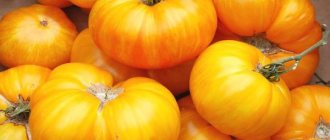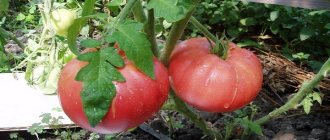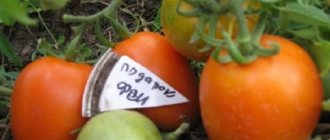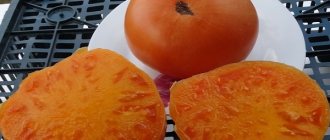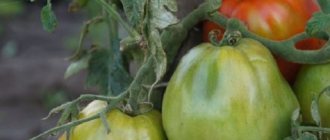| Ripening period: | late ripening, from 120 to 140 days from germination to fruit harvesting |
| Shape, weight of fruits: | flat-round, weight more than 150 g. |
| Bush type: | indeterminate variety up to 1.5 m high |
| Growing regions: | all Russia |
| Productivity: | 3.5 kg per bush with proper agricultural technology |
Having harvested the harvest in the fall, at the end of December you can serve dishes from home-grown tomatoes to the festive table if the gardener grew New Year's tomatoes on his plot. They are stored for a long time and are ideal for canning and pickling. Tomatoes of this variety are elastic and tasty, easy to grow. With proper agricultural technology, tall bushes produce garlands of large tomatoes.
Characteristics and description of the New Year variety
The New Year tomato variety has been added to the State Register of Breeding Achievements. Year of inclusion: 1999.
The creator and patent holder of the variety is Gavrish Breeding Company LLC. Bred for gardens, vegetable gardens, small farms and personal plots. Growing time: spring and summer. They have a long shelf life: they are stored for 3-5 months, until January.
Ripe fruits are harvested on average 125 days after emergence. This is an indeterminate type of plant with a medium-sized bush.
The register gives the following description of the vegetable crop: medium-sized branches, small leaves, bright green, without shine.
The tomato has a simple inflorescence, and the first ones are formed above the 9th leaf, and the next ones appear every 3 leaves.
Ripe tomatoes of the New Year variety have a shade from yellow to intense orange. The fruit has the following characteristics:
- thick, dense peel;
- small seeds;
- flat-round shape;
- pale green color during technical ripeness;
- orange color when fully ripe;
- the surface is smooth, glossy.
- weight from 120 to 200 g.
The species was created for winter consumption. The predominant positive properties are the late ripening of fruits and the preservation of high taste qualities for a long time. While many other varieties retain their taste and freshness only until mid-November. The yield of the cultivar is 7-9 kg per square meter. m.
The tomato variety allows you to use the seed of an overripe fruit to grow tomatoes next year.
New Year's tomato variety on video
You can see other varieties of tomatoes that can be stored until spring in our selection of Tomatoes for long-term storage. Enjoy watching!
If you grew New Year's tomatoes, please write in the comments why you liked this variety, and why, perhaps, it disappointed you. Is its taste really preserved after long-term storage? Briefly describe the advantages and disadvantages of this tomato in your opinion, and evaluate its taste.
Your feedback on the New Year's tomato variety and additions to the description will help many gardeners evaluate this variety objectively and select the best tomato varieties for long-term storage.
This is a natural variety of tomato. Therefore, we recommend taking seeds from a ripe fruit and using them for planting in subsequent seasons.
Growing and care
The New Year's tomato variety is suitable for planting in open ground and under film covers.
Manufacturers advise starting to sow tomato seeds for seedlings in the 3rd decade of March.
When the first developed leaf appears, the seedlings are picked. It is recommended to plant in open soil, in a greenhouse or under a film cover in mid-May. By this time, the seedlings should reach 50-55 days of age.
Tomato reacts painfully to temperature changes in late spring. Therefore, two weeks before moving into the ground, seedlings need to be hardened.
General principles of growing and caring for the New Year tomato variety:
- Planting pattern: 40 by 60 cm.
- Tying tomatoes to supports.
- Formation into one stem.
- Carrying out stepsoning.
- Thinning the ovary.
Since the New Year's tomato bush is of the indeterminate type, it is constantly gaining growth. Plants will stop growing only with the cessation of vital activity. That is why tomatoes must be tied up and the tops pinched.
It is not necessary to water too much during the growth period. But during the period of fruit ripening, the conditions of care change. Watering becomes abundant: about 6 liters of water per bush. It is important not to forget about fertilizing during flowering and fruiting, weeding, and loosening.
Advice from agronomists
To enjoy the tomato harvest at the end of the year, you should follow the growing rules:
- plant seedlings on March 10-15;
- picking in the phase of one true leaf;
- fertilizing with mineral fertilizer for seedlings;
- illumination with an agricultural lamp;
- hardening, ventilation;
- moderate watering;
- fill the soil with complete mineral fertilizer (nitrogen, potassium, phosphorus);
- placement on beds at the age of 50 days (6 true leaves);
- adding calcium nitrate during planting will strengthen the plants (1 tablespoon per hole, sprinkle with soil);
- planting pattern: 40 cm x 60 cm;
- It is recommended to mulch the soil (to facilitate maintenance);
- must be formed into 1 stem;
- to lighten the ovaries;
- brushes and stems need to be tied;
- Do not overexpose ripe fruits on the bushes.
The advantage of the variety is the resistance of the fruit to cracking. But you should water it moderately: 5-6 liters per bush after the soil has completely dried. It is optimal to arrange drip irrigation. It is recommended to place 4 plants per m² of area.
Diseases and pests
The creators of the New Year variety claim that the fruit is resistant to the following diseases:
- tobacco mosaic virus - manifested by the presence of light and dull green spots on leaves, brown cracks on tomatoes.
- Cladosporiosis of tomatoes most often affects bushes planted in open ground. The bushes become spotted due to the abundance of brown spots that appear. As a result, plants and crops die.
- Fusarium - wilting of the plant and death of tomatoes.
Regardless of manufacturers’ statements, measures must be taken to prevent plant diseases:
- Before planting, it is recommended to soak the seeds in disinfecting solutions. Last year's dried tops must be removed from the site and burned.
- Till the soil and carry out pinching with a clean, disinfected piece of gardening equipment.
- Do not allow excess soil moisture when watering.
Experienced gardeners recommend inspecting tomato leaves and stems every day for pests. Early detection of insects that threaten the development of seedlings will help to promptly treat the plant.
Plant care
There are some other rules of care that require you to strictly follow:
Watering should be done as needed or when the soil begins to dry out. Tomatoes love moisture very much, so watering should be done no more often and no less than twice a week, twice a day.
It is especially important to monitor humidity during ripening, because during this period the plant needs water most. This is necessary for the tomato to fully ripen. As your tomato bush grows, you should inspect it and trim off unnecessary
It is best to leave no more than four stems on the bush so that the development of tomatoes does not slow down. And if you do not listen to this advice, then there is a high probability that the yield will be unsatisfactory. Seedlings should be weeded as often as possible to avoid the appearance of weeds that will negatively affect the development of the plant. Another very important procedure for a tomato plant is pinching. All tomato shoots that do not participate in the development of the fruit must be removed. Otherwise, the “stepchildren” will begin to grow without control, and then the main plant will be deprived of moisture and nutrients. The grown shoots should be strengthened and tied to a support. If you think that the soil is not nutritious, then it should be fed with potassium or nitrogen fertilizers.
Advantages and disadvantages
The New Year's tomato variety has a number of advantageous differences from other types of tomatoes.
A number of main advantages include:
- Stable harvest.
- Persistent immunity to a range of diseases.
- Resistance to fruit cracking.
- Good transportability and high shelf life.
Disadvantages include the height of the bush: the need to tie up long stems of the plant and carry out pinching. And also some lovers of juicy fruits note the hard shell of New Year tomatoes. This property also has its advantage: tomatoes are well suited for pickling. The fruits do not crack and retain their shape.
Description of the hybrid tomato Jadwiga and rules for growing the plant
For lovers of early ripening varieties, the Jadwiga F1 tomato will be a real find. This type of nightshade was developed in Japan. Breeders tried to create a universal variety that could produce high yields in different climatic conditions, and they succeeded.
Jadwiga tomatoes tolerate heat and minor temperature changes well. The taste of the tomato receives the highest reviews, and the sugary pulp and aromatic juice are suitable for universal use.
Many vegetable growers are very happy to grow the Jadwiga variety in their gardens. This type of tomato has proven itself well in many countries around the world. It is capable of producing high yields under extreme weather conditions.
Features of the variety
The Yadviga F1 variety is a semi-determinate species; the height of the bush reaches an average of 150-180 cm. It has a powerful root system that nourishes and supports the plant during periods of weather changes. The bush has a compact and neat appearance.
Gardeners recommend forming the plant into 2 trunks. The foliage is medium in size, regular in shape and dark green in color. The stems are strong with a short internode. The Jadwiga tomato is suitable for growing both in greenhouses and hotbeds, as well as in open ground.
The early-ripening variety produces the first harvest within 80-85 days from the moment of the first shoots. The inflorescence is ordinary. The first brush is formed after 6-7 leaves. About 6 large fruits are tied to 1 cluster. An adult bush can have up to 11 brushes. The plant needs additional support and garter.
- The fruits of the Jadwiga tomato are quite large, the weight of 1 tomato reaches 200-220 g.
- The shape of the fruits is round, smooth and dense. They have a fairly strong peel, which prevents cracking.
- Tomatoes ripen at the same time, which makes harvesting easier.
- The tomatoes have a uniform red color, there is no spot around the stalk.
- The taste is excellent.
- The tomato is suitable for fresh consumption and preparation of various types of tomato products.
The characteristics of this type of nightshade show that the plant is resistant to many fungi, especially late blight, verticillium and fusarium race 1.
Similar varieties
According to the characteristics and description of the variety, the New Year's tomato can be compared with the following cultivars:
- Giraffe;
- Lyozhky;
- Yellow ball;
- Farm salting plant.
The Giraffe variety is a tall plant with a late ripening period (130-140 days). The originator is the Gavrish company. Tomato fruits are yellow in color and weigh 120-130 g. have a round shape. The yield from 1 bush with proper agricultural technology is 4.5 kg. Tomatoes can be stored for up to six months. The tomato is resistant to tobacco mosaic virus and cladosporiosis.
Tomato Lezhkiy is a late-ripening cultivar with excellent taste. The plant reaches 1 m in length. The bright orange fruits are flat-round, sweet, weighing up to 120 grams. The skin is dense and resistant to cracking. If stored properly, tomatoes can last until the New Year. The vegetable crop is resistant to a complex of tomato diseases.
Yellow ball is an indeterminate tomato up to 2 meters high. Refers to new varieties with an average early ripening period of 110 days. Suitable for growing in greenhouses and unprotected soil. The month of the beginning of fruiting is July. The weight of the fruit can reach 150-160 grams. Productivity per plant is from 2.5 to 3 kg. Tomatoes are resistant to the nightshade disease complex.
Khutorskoy salting is a late-ripening variety with a ripening period of 120-130 days. Recommended for growing in greenhouses and under film covers. The plant is classified as indeta (tall). The fruits are yellow in color and round in shape with a dense peel, weighing 90-100 g. They have good shelf life and can be stored for up to 5 months without losing their presentation. The cultivar is resistant to fusarium, cladosporiosis and tobacco mosaic.
What’s so special about this variety?
A gardener grows tomatoes, processes them, and dreams of keeping them fresh longer. I really want to cut a salad from a normal tomato! Regular varieties last until early November.
The breeders of the Gavrish company pleased the hardworking summer residents. The New Year variety is created for winter consumption.
Description of tomato:
- indeterminate variety;
- the bush grows up to 150 cm;
- bears fruit in open ground and unheated greenhouses;
- late ripening period (140 days from loops to fruit harvesting);
- prone to being overgrown with leaves;
- dark green plates;
- the first brush is formed after the 9th leaf;
- competent agricultural technology will ensure a yield of 3.5 kg/m².
Gardeners are attracted by the variety’s resistance to TMV, fusarium, and cladosporiosis. To protect against late blight, you should monitor the weather, use preventive spraying with copper-containing preparations (according to instructions) or serum (1 liter per 10 liters of water, ten drops of iodine).
Breeders have worked on the properties of tomatoes. Tomatoes are picked unripe. They ripen in a dark, warm place. It is necessary to cover the box with a cloth: this will prevent drying out.
Some gardeners salt and marinate small fruits whole. Tomatoes do not crack and decorate canned food.
